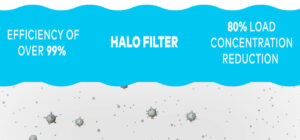 While we go about our days, we assume the air we breathe is clean and free of contamination. After all, if we can’t visually see any pollution, our perception is that we must be breathing clean air. However, contrary to this belief is the reality that we are breathing more polluted air than our bodies were ever intended to handle. Even more concerning is the very same buildings we spend most of our time in are assumed safe but pose the most significant risks contributing to what is known as sick building syndrome (SBS), significantly compromising our overall health.
While we go about our days, we assume the air we breathe is clean and free of contamination. After all, if we can’t visually see any pollution, our perception is that we must be breathing clean air. However, contrary to this belief is the reality that we are breathing more polluted air than our bodies were ever intended to handle. Even more concerning is the very same buildings we spend most of our time in are assumed safe but pose the most significant risks contributing to what is known as sick building syndrome (SBS), significantly compromising our overall health.
Air quality statistics paint a dire picture
The importance of understanding the impact of poor Indoor Air Quality (IAQ) cannot be ignored especially considering that we spend 90% of our time indoors. While we all understand that polluted air is bad, and I am sure nobody would want to expose themselves to continuous exposure to pollution voluntarily, it is exactly what we unknowingly do. Let’s put this into a bit of perspective; The average human breathes in 8-10 liters of air for every minute, or ~11,000 liters, per day. In a communal setting, we can also factor in 3% of someone else’s air with every breath we take.

Yet, even with this knowledge, no regulatory actions on the state or federal level have been implemented to address the air quality inside our buildings (IAQ). The impact on our health is undeniable as there are an estimated 6 million premature deaths annually, and millions of unhealthy people, due to the air we breathe. This doesn’t include airborne transmittable diseases. The calvary is not coming – we must take control of our own environment.
Surmounting the hurdles
 What is meant by ‘improving your building’s Heating, Ventilation, and Air Conditioning (HVAC) system.’ The suggested improvements include increasing ventilation rates and increasing the HVAC filter to at least a MERV 13. If neither of these is possible, it is suggested to supplement a filtration strategy with portable HEPA filter systems. So, let’s first start by breaking down the proposition to increase ventilation rates, or what is known as bringing in more outdoor air. The more air we bring in, the more we will have to condition either by heating or cooling and adding additional humidity controls. In our discussion on the subject of heated and cooled air, we should not overlook the fact that when overhead vents (or diffusers) are supplying heated air to a room that is thermally stratified, (when dense and light air meet one another) conditions are created that actually ‘block;’ the flow of clean air down into the breathing zone. As a result, even when people are sitting more than 6 feet from each other, some occupants may be exposed to respiratory aerosols from others at a rate 5 to 6 times higher than if the same room had well-mixed air.
What is meant by ‘improving your building’s Heating, Ventilation, and Air Conditioning (HVAC) system.’ The suggested improvements include increasing ventilation rates and increasing the HVAC filter to at least a MERV 13. If neither of these is possible, it is suggested to supplement a filtration strategy with portable HEPA filter systems. So, let’s first start by breaking down the proposition to increase ventilation rates, or what is known as bringing in more outdoor air. The more air we bring in, the more we will have to condition either by heating or cooling and adding additional humidity controls. In our discussion on the subject of heated and cooled air, we should not overlook the fact that when overhead vents (or diffusers) are supplying heated air to a room that is thermally stratified, (when dense and light air meet one another) conditions are created that actually ‘block;’ the flow of clean air down into the breathing zone. As a result, even when people are sitting more than 6 feet from each other, some occupants may be exposed to respiratory aerosols from others at a rate 5 to 6 times higher than if the same room had well-mixed air.
The proper suggested increase in ventilation rate is also known as Air Change Rates (ACH). For example, take a classroom-based on an occupancy load between 25-35 students, here ASHRAE 62.1 recommends between 3-6 ACH. If we used this standard or recommendation, a classroom estimated at 8,000 cu’ would need 533 Cubic Feet Per Minute (CFM) or 32,000 Cubic Feet Per Hour of air which will also need to be processed.
![]() Defining energy load in relation to costs
Defining energy load in relation to costs
Okay, but what does this mean for your energy load. Let’s take a moment to break that down as this is where the cost for air really starts to become clear. We are going to attempt to simplify what is a very complex equation.
We all understand the cost per kilowatt-hour kWh, so if we take the national commercial average cost per kWh, which is at $0.10, and factor in the HVAC system running 8 hrs./day, 5days/week, or 4,350 hrs./year, the total energy consumption used per year for that one room would be 40,457kWh/yr. Now we factor that kWh cost in at $0.10, and our annual energy cost is $4,045. These calculations also assume make-up air consumption, exhaust air consumption, and chiller consumption, which may or may not be completely relevant to your situation but is the best way to provide average costs. If we take that cost and multiply it by the total number of classrooms, offices, etc., you have your estimated annual energy cost per year. While I would agree this is a bit simplified and variables would occur, we do provide enough detail to understand the significant impact adding ACH has on your operational cost expenditures.

The calculation above assumes you have the infrastructure to meet the demands of increasing the facilities ACH and upgrading to MERV 13 filters, but what if you don’t. If the scenario was that you needed to have a new HVAC system designed and installed, then we would be talking about a capital cost expenditure of about $18 per square foot. If we were to take the national square foot average of a school (85,000) your total first costs would be ~ at $1.5m. Using the above equation to calculate our total cfm need
would be a total required 14,166 cfm, which would consume an estimated annual energy cost of $128,000. We haven’t even started discussing the amount of Co2 which is generated, which would be roughly about 738,000 lbs./year.
Ventilation is a crucial element in a healthy environment
While proper ventilation plays a crucial role in maintaining a healthy environment, you need to ensure your ventilation systems are operating properly, which includes proper Air Exchange Rate (ACH), MERV 13 or higher filters, clean-to-dirty directional airflow patterns, room balancing, fresh air dampers, and relative humidity control. Sound complicated? It is, and extremely expensive as outlined above.
Air purifiers can capture viruses in the air, helping to reduce the concentration in the room and reducing the potential for exposure. They also assist in keeping potentially contaminated air within one room, as opposed to operating off the premise of dilution followed by recirculation (see diagram).

Most buildings have a centralized system, which means polluted air is distributed throughout the building before getting diluted or filtered. This means that one contaminated person’s nuclei (droplets) could spread to many different areas, posing a serious risk to other occupants.
Arriving at a logical, sustainable solution
Capturing the aerosolized contaminants as close to the source as possible is the key to mitigating the risk of any aerosolized contamination. This can be accomplished with laboratory-grade H14 HEPA, or molecular filtration and proper directional  airflow patterns. With complete freedom from the building’s HVAC, your cost is reduced, installation is expedited, and contamination re-entry throughout the HVAC system is also mitigated.
airflow patterns. With complete freedom from the building’s HVAC, your cost is reduced, installation is expedited, and contamination re-entry throughout the HVAC system is also mitigated.
Though we are all focused on the current pandemic, we must also look at the bigger picture of pollution and the impact this has on our overall health and, yes, the inevitability of preparing for another virus. Reducing our exposure to PM 2.5 is a critical factor in keeping viral susceptibility at bay, but we also must account for the cumulative exposure to Volatile Organic Compounds (VOCs). One such VOC is formaldehyde. Heat and humidity accelerate the release of this toxic chemical which is present in a myriad of building materials, smoking, and many manufactured products, that we are all exposed to every day.
The price we pay now, and that future generations will inherit, is air that sickens us. Contamination is winning – as evidenced by the surmounting, very real loss of daily human health and lives.
No longer should dilution be the solution. In fact, this mindset is poisoning us. Capturing and containing at the source of the problem is the proven, logical conclusion. The best way to mitigate our risk is HALO air filtration in all commercial spaces where people gather – so we can breathe!
Reference Note Links:
EPA Indoor Air Quality Report
Health Effects of Air Pollution
Links for more information:
Will an air cleaner or air purifier help protect me and my family from COVID-19 in my home?
AC and duct cleaning has no effect on Covid-19 spread
Scientists Pin Blame for Some Coronavirus Deaths on Air Pollution, Pfas, and Other Chemicals



